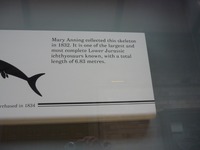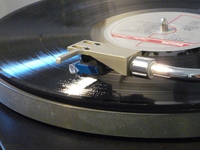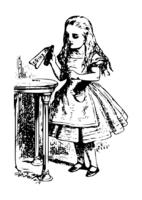Items
Site
The Medicine Chest
keywords is exactly
arrested development
-

A label in the Natural History Museum
A label in the Natural History Museum accompanying a discovery made by Mary Anning. -

Coda
Metronome, fishing hook, sinker, crimp and laboratory clamp. The fishing sinker supplies a counter weight, which allows ticking to continue even though the metronome is suspended upside down. The weight is however, exercising a force which will inevitably exhaust the metronome spring, causing it to cease functioning. -

Burrowing
Extract from 'A Child in Time': "Later, in the sorry months and years, Stephen was to make efforts to re-enter this moment, to burrow his way back through the folds between the events, crawl between the covers, and reverse his decision. But time – not necessarily as it is, for who knows that, but as thought constituted it – monomanically forbids second chances" (McEwan 1987: 14). -

Mozart's Antimony
Medical bedside cabinet, gramophone player with a hypodermic needle substitution, Mozart’s Sonata in C, KV 279 and Sonata in D, KV 576. The needle is slowly scratching irreparable grooves into the record whilst the record in return, is making the needle blunt.. "On 20 October 1791, Mozart told his wife Constanza that he was being poisoned. On 20 November he developed a fever; his hands, feet and stomach became swollen, and he had attacks of vomiting. He died on the 5th of December. Although Antonio Salieri confessed to Mozart’s murder several years later, it is highly unlikely as Salieri suffered from senile dementia. In 1991, Ian James of London’s Royal Free Hospital attributed Mozart’s death to antimony, a poison that Mozart may have been given by his doctor - not to kill him but to cure him. Antimony was prescribed for what was then diagnosed as melancholia. In small doses it leads to headaches, fainting and depression. In large doses it can be fatal within days (Emsley 1999: 225). In the autumn of 1791, Mozart, suffering from severe depression, exacerbated by debt, the ill reception of his new work La Clemenza di Tito, and a commission to write a requiem which he believed was for his own funeral, dosed himself with a variety of medicines – one of these being antimony – and what was meant to cure, killed" (Liebenberg 2011: 85 - 91). -

Woman, woman, let go of me
In the chapter he titled, 'When Wendy Grew Up', J.M. Barrie recalls how Wendy tried, for Peter’s sake, not to have growing pains – and how she even felt untrue to him when she got the prize for general knowledge. But the years came and went without bringing the careless boy and Wendy eventually grew up and got married. If you feel sorry for her, don’t. Barrie tells us that Wendy was the kind of girl that liked growing up and that in the end, “ she grew up of her own free will a day quicker than other girls” (1989:182). All grown up with a daughter of her own, Peter visits her again one night while she’s sitting in front of the fire, darning. She hears the crow call and the window blows open as of old, Peter dropping to the floor – looking exactly the same as ever. “He was a little boy, and she was grown up. She huddled by the fire not daring to move, helpless and guilty, a big woman. ‘Hallo, Wendy,’ he said, not noticing any difference, for he was thinking chiefly of himself; and in the dim light her dress might have been the nightgown in which he had seen her first. ‘Hallo, Peter,’ she replied faintly, squeezing herself as small as possible. Something inside her was crying, ‘Woman, woman, let go of me’” (1989: 185 - 186). -

The hidden life within
-

Forest (process)
A collection of Echinacea angustifolia tea rings read by botanist and dendrochronologist, Dr Edmund February. A molecule found in the Echinacea angustifolia plant prevents a caterpillar on eating it, from ever turning into a butterfly. Example of a specimen reading: “It would appear that the tree stood on a slope since there is more compression on the left hand side, which indicates that side was under less tension. It could also be a branch of which the left hand side would be its underside. The rings are uniformly wide which suggests plenty of soil and moisture availability. In comparison with the other two trees, the outer rings suggest less water or more competition.” -

Forest
A collection of Echinacea angustifolia tea rings read by botanist and dendrochronologist, Dr Edmund February. A molecule found in the Echinacea angustifolia plant prevents a caterpillar on eating it, from ever turning into a butterfly. Example of a specimen reading: “It would appear that the tree stood on a slope since there is more compression on the left hand side, which indicates that side was under less tension. It could also be a branch of which the left hand side would be its underside. The rings are uniformly wide which suggests plenty of soil and moisture availability. In comparison with the other two trees, the outer rings suggest less water or more competition.” -

Fairytales warn us...
"The fairytales warn us that there is no such thing as standard size – that is an illusion of industrial life – an illusion farmers still struggle with when trying to supply uniform vegetables to supermarkets … no, size is both particular and subject to change. The stories of the gods appearing in human form – scaled-down power deities – are also stories against judging by appearances – things are not what they seem. It seems to me that being the right size for your world – and knowing that both you and your world are not by any means fixed dimensions – is a valuable clue to learning how to live" (Winterson 2011: 35). -

The Curious Case Of Benjamin Button


